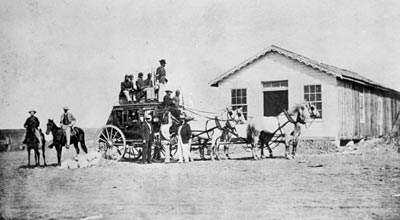|
On July 28, 1866, the United States Congress passed legislation to establish two cavalry (9th and 10th) and four infantry regiments, (38th, 39th, 40th, and 41st) to be made up of African American enlisted men. (2) Three years later in 1869, the four infantry regiments were consolidated into two regiments, the 24th and 25th Infantry. The troops were paid thirteen dollars a month, plus room, board and clothing. Enlistment was for five years. Almost immediately these new regiments were transferred to the western states and territories for service on the American frontier. The regiments spent their time scouting and patrolling vast expanses of challenging terrain, providing sentinels and security for the settlers, building roads, and installing telegraph lines. (3) They also spent endless hours on the necessary military tasks of drills, inspections, parades, and the care and maintenance of their horses and equipment. (4) The troopers faced a mix of danger and boredom accentuated by rigid military discipline. They fought in more than one hundred twenty-five engagements in campaigns against the Cheyenne, Apache, Kiowa, Ute, Comanche, and Sioux. (5) The Black regiments were frequently ordered to return hostile tribes to their appointed reservations. A large percentage of the troops had been born into slavery. Some soldiers were Seminole Negroes, whose ancestors had fled slavery and joined Seminole tribes in Florida. These activities involving Native Americans created feelings of moral dilemma and a sense of irony for many of the Black troops. 
Many soldiers were recognized for their valor, and several were awarded the Medal of Honor. Sergeant Emanuel Stance was the first black regular to be awarded the Medal in June 1870. Twenty-two year old Sergeant Stance was among the first troops to enlist in the 9th Cavalry. Leading a small patrol near Kickapoo Springs, Texas, Stance saw a group of about 20 Apache approaching a herd of government horses and their guard detail. After a long, mounted skirmish, the Buffalo Soldiers eventually drove off the Apache and captured 15 of their horses. In recognition of his gallantry and decisive leadership, Stance's company commander recommended him be awarded the Medal. (6) In the next twenty years, sixteen Black men received the Medal of Honor. Many other soldiers who distinguished themselves received the Certificate of Merit, and untold others received no official recognition for their acts of bravery. The first Black commissioned officer to lead men in a Buffalo Soldier regiment, the 10th Cavalry, was Lieutenant Henry O. Flipper, West Point class of 1877. (7) Two more academy graduates would eventually follow him, John Hanks Alexander, class of 1887, and Charles Young, class of 1889. They were joined by five other African American officers, chaplains: Allen Allensworth (24th Infantry), Henry V. Plummer (9th Cavalry), George Prioleau (9th Cavalry), Theophilus Gould Steward (25th Infantry), and William Anderson (10th Cavalry). (8) Chaplains were accorded the same respect due a military officer but did not lead troops. The Black chaplains were responsible for the spiritual needs of the four segregated regiments and also acted as school teachers for those soldiers who needed a basic education. All of the African American officers faced challenges from both their adversaries on the plains and their colleagues on the post. Even though the army had an official policy of non-discrimination it could not guarantee equality or social acceptance. Not a single Black enlisted man rose through the ranks to commissioned officer from the year the Black regiments were established in 1866 until the beginning of the Spanish-American War in 1898, when the Buffalo Soldiers would be engaged overseas for the first time. (9) 
Following the 1890 Pine Ridge campaign, fewer troops were needed to preserve and maintain order on the frontier. The War Department closed many of the smaller frontier forts and outposts. Companies of soldiers were transferred to larger garrisons, such as Fort Robinson, Nebraska, Fort Riley, Kansas and the Presidio of San Francisco. In the 1890s the Afro-American soldiers' spent much time guarding property during labor strikes. They also participated in experiments with new weapons and equipment. In a test to see if horses could be replaced with bicycles, the 25th Infantry conducted the most extensive field trials. In 1896 seven men of the 25th Infantry rode bicycles on a 790-mile round trip between Fort Missoula, Montana and Yellowstone National Park. The following year, 20 Buffalo Soldiers mounted on bicycles rode 1,900 miles from Fort Missoula to Saint Louis, Missouri. The onset of the Spanish-American War brought an end to these tests, and military cycling was never put to effective use. (10) By this time, Black troops comprised 20 percent of the United States Cavalry. Along with the 24th and 25th Infantry, these soldiers had played a significant role in the American West. The Buffalo Soldiers had created a place for themselves in the United States Army, and despite the hardships and discrimination of the 19th century proved themselves to be equal to any man in service to his country. < Return to Buffalo Soldier Home |
Last updated: February 9, 2022
